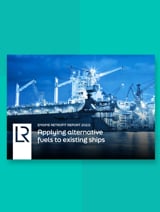Compare readiness levels
Hovering over graphs to display readiness levels. You can compare all fuels together, individually and readiness levels on their own by clicking on they coloured labels. Hovering over graphs will display readiness levels.
Exploring the advantages of methane as a marine fuel
- Acceptable energy density: methane has a high energy density, with similar storage capacity and refuelling frequency requirements to conventional natural gas.
- Compatibility: methane can leverage existing natural gas infrastructure and can be used in existing internal combustion engines without significant modifications, reducing emissions involved in creating new infrastructure.
Risks and disadvantages
- Methane slip: methane slip occurs when methane, a potent GHG, is not completely combusted in an engine and instead is emitted into the environment.
- Environmental considerations: leakage of methane during production, storage, or transportation poses environmental risks.
- Safety considerations: Although non-toxic, in large quantities methane can displace oxygen in air, potentially resulting in suffocation. Additionally, it is highly flammable.
Differences between methane fuels
| Liquefied bio-methane |
Liquefied bio-methane is from animal manure or lignocellulosic feedstocks. The feedstock undergoes anaerobic digestion and upgrading processes or gasification and catalytic methanation processes to produce methane. The methane is then liquified.
|
|
Liquefied e-methane |
Liquefied e-methane is produced using carbon dioxide and e-hydrogen. The carbon dioxide is obtained through Direct Air Capture (DAC), and e-hydrogen gas is produced using renewable energy to separate the hydrogen from water through electrolysis. The carbon dioxide and e-hydrogen go through a methanation process to form methane, which is then liquefied.
|
Methane readiness insights
Resources |
||||
| Fuel Type | Rating | Description | Justification | Challenge |
| Liquefied bio-methane | 7 | Low-scale pilot production demonstrated | Pilots have been demonstrated, however current supply would not meet shipping demands | Strong demand signals are needed to stimulate scale-up of supply for shipping |
|
Liquefied e-methane |
7 | Low-scale pilot production demonstrated | Pilots have been demonstrated, however current supply would not meet shipping demands | A scaled up supply chain and workforce needs to be established for the supply of renewable electricity as well as sustainable carbon sourcing. For this scale-up to take place, there will need to be demand signals from the market. |
Production |
||||
| Fuel Type | Rating | Description | Justification | Challenge |
| Liquefied bio-methane | 2 | Technology concept formulated | Anaerobic digestion and liquefaction is well established (manure feedstock), however production of ligno methane has not been demonstrated beyond concept stage. | Liquefaction and transportation challenges need to be addressed, although the investment case needs to be proven before technology development will continue for ligno methane as a marine fuel |
| Liquefied e-methane | 2 | Technology concept formulated | Production of liquefied e-methane has not been demonstrated viable beyond concept stage. Additionally, liquefaction and transportation is not yet in place | Electrolysis facilities need to be industrialised at scale and direct air capture facilities need developing past prototype stage, however the investment case needs to be proven before technology development will continue for liquefied e-methane as a marine fuel |
Bunkering and ports |
||||
| Fuel Type | Rating | Description | Justification | Challenge |
| Liquefied bio-methane | 7 | Low scale pilot production demonstrated | Bunkering and port infrastructure are in place and proven with LNG, however liquid bio-methane and liquefied e-methane supply chains for shipping do not yet exist | Fuel supply chains need to be scaled for shipping |
| Liquefied e-methane | ||||
Ship - Onboard handling and storage |
||||
| Fuel Type | Rating | Description | Justification | Challenge |
| Liquefied bio-methane | 9 | Production and product fully operational | The technology is fully operational and proven with LNG, and directly transferrable with pure methane | Fuel supply chains need to be scaled for shipping, and will use existing operational infrastructure and technology. |
| Liquefied e-methane | ||||
Ship |
||||
| Fuel Type | Rating | Description | Justification | Challenge |
| Liquefied bio-methane | 8 | Manufacturing fully tested, validated and qualified | The technology is fully operational and proven with LNG, and directly transferrable with pure methane | Fuel supply chains need to be scaled for shipping, and will use existing operational infrastructure and technology. However, this technology needs to be refined to eliminate or at least mitigate methane slip. |
| Liquefied e-methane | ||||
Resources |
||||
| Fuel Type | Rating | Description | Justification | Challenge |
| Liquefied bio-methane | 1 | Hypothetical commercial proposition | No commercial trials as yet. | Signals need to be provided to investors that show a stable, attractive market, in order to stimulate scale-up of supply |
| Liquefied e-methane | 2 | Commercial trial, small scale | Commercial supply chains are not yet developed into a competitive market | There is a need to reduce risks of investing in countries with low credit ratings because many of these countries are well suited to provide renewable resources and will therefore be required for scale up of supply. Additionally the sustainable sourcing of carbon needs to be proven economically viable. |
Production |
||||
| Fuel Type | Rating | Description | Justification | Challenge |
| Liquefied bio-methane | 1 | Hypothetical commercial proposition | There are no commercial trials yet of liquefaction and transportation of methane | The liquefaction process needs to be proven economically viable, and environmental policy will need to change to stimulate demand and investment |
| Liquefied e-methane | 1 | Hypothetical commercial proposition | No commercial trials of direct air capture for shipping yet | Sustainable sourcing of carbon and the liquefaction process need to be proven economically viable and competitive, and environmental policy will need to change to stimulate demand and investment |
Bunkering and ports |
||||
| Fuel Type | Rating | Description | Justification | Challenge |
| Liquefied bio-methane | 1 | Hypothetical commercial proposition | No commercial trials as yet. | Increased demand from for methane (rather than LNG) as a fuel is needed, although investment at ports will be minor as the infrastructure already exists for LNG. |
| Liquefied e-methane | ||||
Ship |
||||
| Fuel Type | Rating | Description | Justification | Challenge |
| Liquefied bio-methane | 1 | Hypothetical commercial proposition | No commercial trials as yet. | Incentives to invest in methane are needed from regulatory change |
| Liquefied e-methane | ||||
Resources |
||||
| Fuel Type | Rating | Description | Justification | Challenge |
| Liquefied bio-methane | 3 | Early stage solution formation to tackle stakeholder issues | Community concerns exist around land requirements for feedstock, and regulatory framework for lifecycle assessment is insufficient to enable the use of biomass derived fuels | Community acceptance is subject to the assessment and mitigation of sustainability implications, such as deforestation and negative impacts from land use changes for feedstock harvesting, and global regulatory framework for lifecycle assessment requires further development and adoption to enable the use of biomass derived fuels. |
| Liquefied e-methane | 4 | Evidence becoming wide-spread resulting in initial stakeholder acceptance | Small scale solutions show some acceptance at a local level, however scaling renewable electricity requires community acceptance around potential environmental and social impacts | Communities need educating on the wider benefits of renewable energy and to dedicate land use for these purposes. Additionally, carbon sourcing certification needs to be in place. |
Production |
||||
| Fuel Type | Rating | Description | Justification | Challenge |
| Liquefied bio-methane | 1 | Stakeholder support or opposition is hypothetical | Resource and production have been proven, however regulatory framework for lifecycle assessment is insufficient | Global regulatory framework for lifecycle assessment requires further development and adoption. This includes addressing concerns around methane emissions in production of bio-methane, and accounting for methane slip in combustion. |
| Liquefied e-methane | 2 | Stakeholder support or opposition is becoming understood as a result of pilots | Scaling the technologies reduces community acceptance of environmental and social impacts | Communities need educating on the implications of using large scale wind farms, solar farms and DAC plants. Additionally, carbon sourcing certification needs to be in place. |
Bunkering and ports |
||||
| Fuel Type | Rating | Description | Justification | Challenge |
| Liquefied bio-methane | 5 | Market competition driving widespread development | Storing LNG is proven and accepted, with regulations in place. The evidence and regulations are directly applicable to liquefied pure methane | Policy is needed to stimulate investment in zero-carbon fuels such as methane. |
| Liquefied e-methane | ||||
Ship |
||||
| Fuel Type | Rating | Description | Justification | Challenge |
| Liquefied bio-methane | 1 | Stakeholder support or opposition is hypothetical | Although Methane (natural gas) is a normative gaseous/low-flashpoint fuel, its methane emissions when used in internal combustion engines is not regulated and proposed solutions are not yet proven | Policy is needed to stimulate investment in zero-carbon fuels such as methane. Additionally, methane slip needs addressing and communities need to be educated on the comparative analysis (against alternative fuels) of other emissions affecting the crew |
| Liquefied e-methane | ||||






